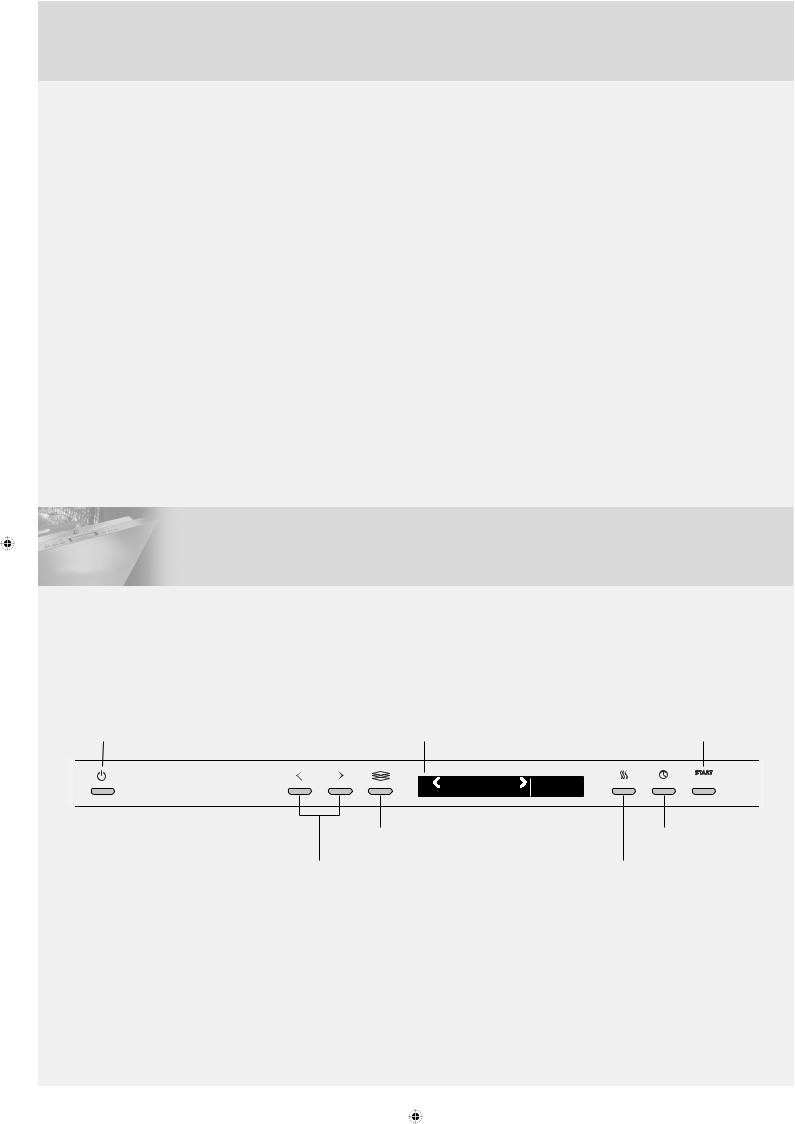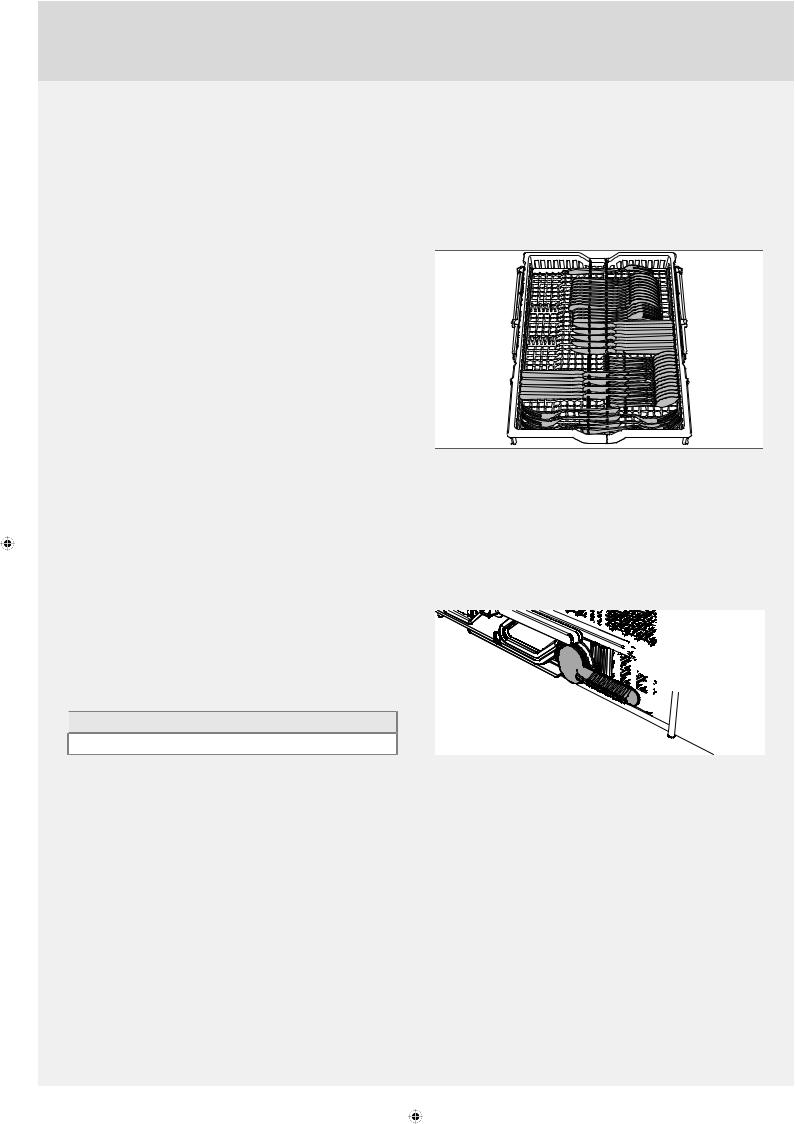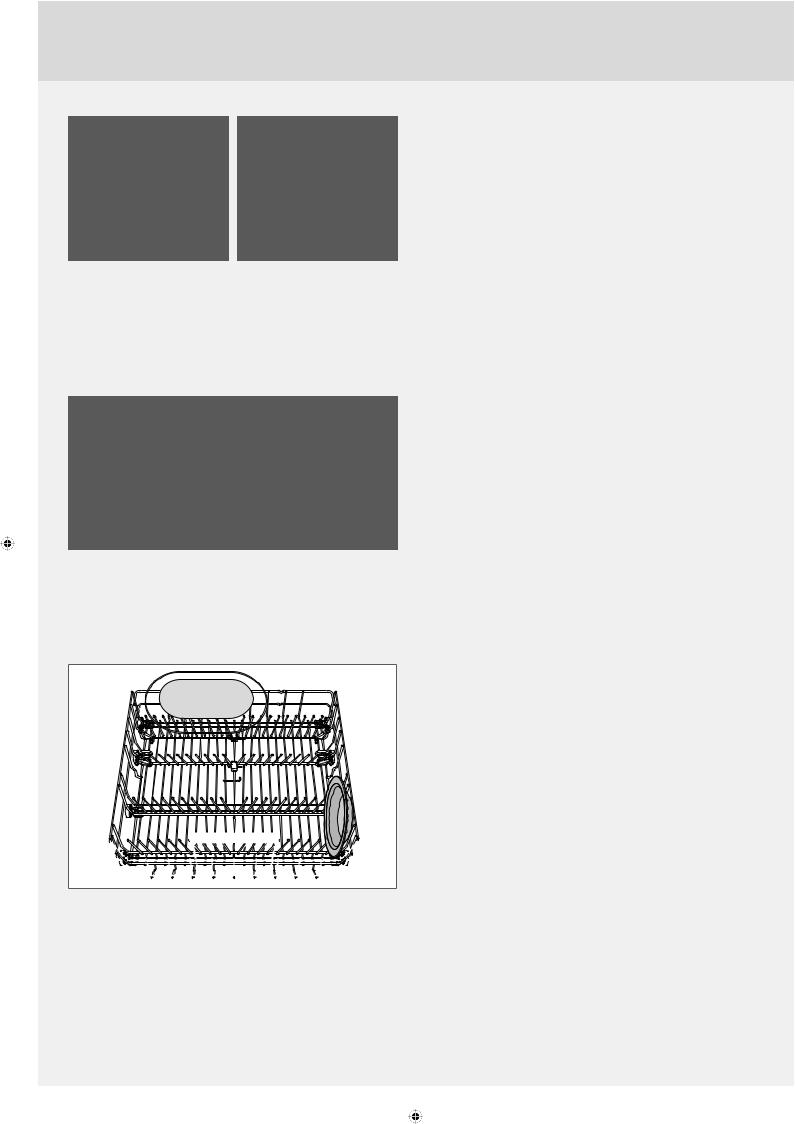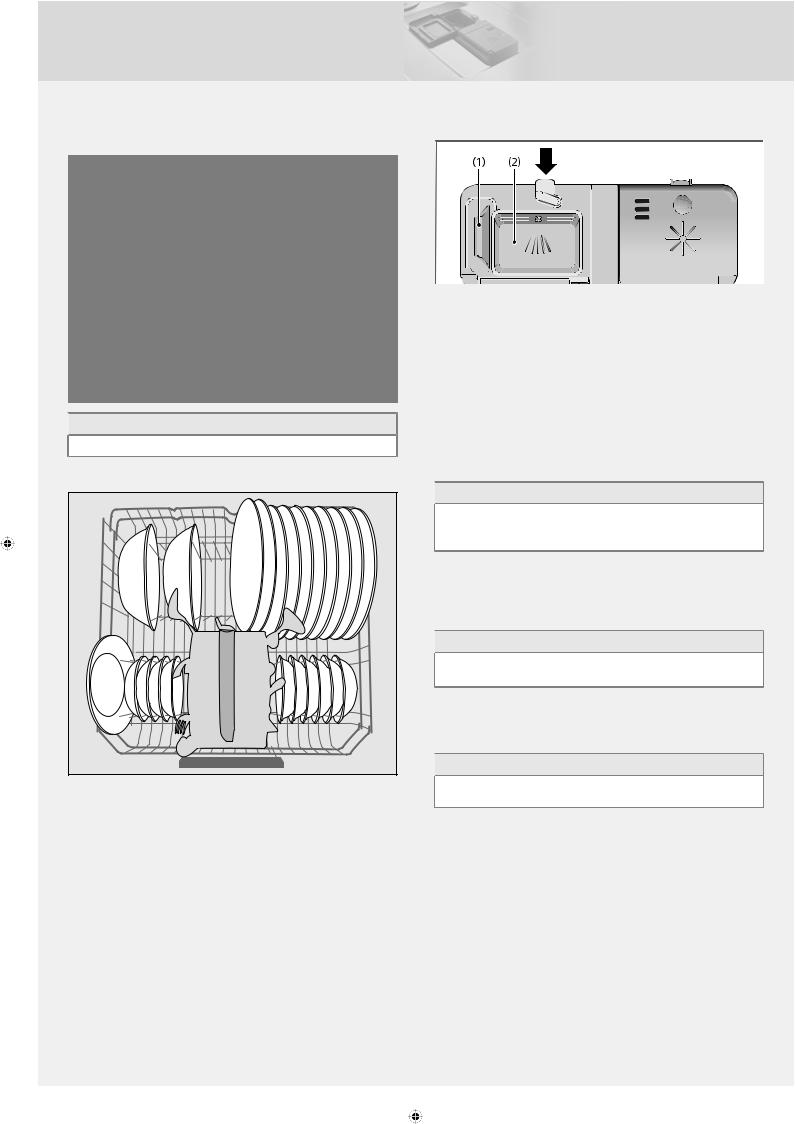Asko DFI664 Manual

OPERATING INSTRUCTIONS |
Dishwasher DFI664 |

Contents
Display panel |
2 |
Troubleshooting |
16 |
Important safety instructions |
3 |
Technical information |
19 |
Before washing for the first time |
4 |
Installation instructions |
20 |
Loading the dishwasher |
5 |
Service |
22 |
Using the dishwasher |
8 |
Notes |
23 |
Settings |
12 |
Quick start guide |
24 |
Care and maintenance instructions |
14 |
|
|
Dear Customer,
Thank you for choosing this quality product from ASKO.
We hope it will meet your expectations and fulfill your needs for many years to come. Scandinavian design combines clean lines, everyday functionality, and high quality. These are key characteristics of all our products and the reason they are greatly appreciated throughout the world.
To get the most out of your new dishwasher, we recommend that you read the operating instructions before using it. The last page also includes a Quick start guide.
Display panel
To switch on the dishwasher, press and hold the main power switch until the display lights up.
"Welcome to your new ASKO. This is a first time set up." is shown on the display the first time the dishwasher is switched on. It is important that you choose the right settings to ensure good dishwashing results. See page 4.
Main power switch |
Display |
|
Start/Stop |
|
|
|
START |
|
Eco |
2:00 |
STOP |
|
|
||
|
Speed mode |
|
|
|
Program mode selector |
|
Option Delayed Start |
|
Navigation buttons for selecting a program |
|
Option Extra Dry |
2

Important safety instructions
SAVE THESE INSTRUCTIONS FOR FUTURE REFERENCE

 WARNING!
WARNING!
When using your dishwasher, follow basic precautions, including the following:
•Read all instructions before using the dishwasher.
•Use the dishwasher only for its intended function.
•Use only detergents or wetting agents recommended for use in a dishwasher and keep them out of the reach of children.
•When loading items to be washed:
–locate sharp items so that they are not likely to damage the door seal, and
–load sharp knives with the handles up to reduce the risk of cut-type injuries.
•Do not wash plastic items unless they are marked “dishwasher safe” or the equivalent. For plastic items not so marked, check the manufacturer’s recommendations.
•Do not operate the dishwasher unless all enclosure panels are properly in place.
•Do not tamper with controls.
•Do not abuse, sit on, or stand on the door or dish rack of the dishwasher.
•To reduce the risk of injury, do not allow children to play in or on a dishwasher.
•Under certain conditions, hydrogen gas may be produced in a hot water system that has not been used for two weeks or more. HYDROGEN GAS IS EXPLOSIVE. If the hot water system has not been used for two weeks, before using the dishwasher turn on all hot water faucets and let the water flow from each for several minutes. This will release any accumulated hydrogen gas. As the gas is flammable, do not smoke or use an open flame during this time.
•Remove the door to the washing compartment when removing an old dishwasher from service or discarding it.
•Read the grounding instructions in the installation instructions.
General
•Do not run the dishwasher while you are out of the home.
•Do not store or use combustible materials, gasoline, or other flammable vapors and liquids in the vicinity of this or any other appliance.
•Disconnect electrical power to dishwasher before servicing.
•Repairs should be done by a qualified technician.

 WARNING!
WARNING!
This product may contain chemicals known to the state of California to cause cancer or reproductive harm.
Installation
See the chapter Installation instructions.
Child safety
 TIP!
TIP!
Dishwasher detergents and rinse aids are corrosive, so always keep them out of reach of children.
•Should a child swallow dishwasher detergent or rinse aid, give plenty to drink immediately, i.e., one or two glasses of milk or water. Do not try to induce vomiting. Seek medical advice immediately: Call the National Capital Poison Center at 1-800-222-1222.
•Always close the door and start the dishwasher as soon as you put in the detergent.
•Always keep small children away from the machine when it is open. There may be some detergent residue left inside the machine.
•If dishwasher detergent gets in someone’s eyes, rinse them with plenty of water for at least 15 minutes.
Activate child lock (Kid Safe™)
You can activate the child lock (button lock) to prevent children from starting the dishwasher. See the chapter Settings.
Winter storage/Transport
•Store the dishwasher where the temperature remains above freezing.
•Avoid long transport distances in very cold weather.
•Transport the dishwasher upright or laying on its back.
Overflow guard function
The overflow protection starts pumping out the machine and turns off the water supply if the water level in the dishwasher exceeds the normal level. If the overflow protection is triggered, turn off the water supply and call the Customer Care Center.
Packing material
The packaging protects the product during transport. The packaging material is recyclable. Separate the different packaging materials to help reduce raw material use and waste. Your dealer can take the packaging for recycling or direct you to the nearest recycling center. The packaging is comprised of:
•Corrugated cardboard made from up to 100% recycled material.
•Expanded polystyrene (EPS) with no added chlorine or fluorine.
•Supports made from untreated wood.
•Protective plastic made from polyethylene (PE).
Disposal
•When the machine has reached the end of its service life and is to be disposed of, it should immediately be made unusable. Pull out the power cable and cut it as short as possible.
•The dishwasher is manufactured and labeled for recycling.
•Contact your municipality for information about where and how your dishwasher can be recycled correctly.
3

Before washing for the first time
1. Checking water hardness
Contact the local water utility to check the water hardness in your area. This is important to determine how much detergent and rinse aid to use.
In general, more rinse aid and detergent are needed for hard water.
2. Basic settings
To switch on the dishwasher, press and hold the main power switch until the display lights up.
"Welcome to your new ASKO. This is a first time set up." is shown on the display. It is important that you choose the right settings to ensure good dishwashing results.
Select setting
Main power switch |
Confirm setting |
Settings
1Language
Select the language to be shown on the display.
2Rinse aid 0/1/2/3/4/5
Use rinse aid to improve wash and dry times. Also use rinse aid to
achieve clear and spotless results.
Select rinse aid dosage. The rinse aid dispenser can be adjusted
between 0 (Off) and 5 (High dosage).
Pre-selected at factory: 5
To change the chosen setting, see the chapter Settings.
4

3. Top up with rinse aid
Use rinse aid to improve wash and dry times. Also use rinse aid to achieve clear and spotless results.
Press to open
1 Open the rinse aid compartment lid.
2Carefully top up with rinse aid. Only add rinse aid to the level marked max.
3 Wipe up any spilled rinse aid around the compartment.
4 Close the lid firmly.
Add rinse aid
When the rinse aid needs topping up, the above symbol lights on the display.
After topping up, it may take a while before the symbol goes out.
 NOTE!
NOTE!
Increase the rinse aid dosage:
•If the dishes have water marks.
Reduce the rinse aid dosage:
•If the dishes have a sticky white/blue film.
•If the dishes are streaked.
•Heavy foaming. If you have very soft water, the rinse aid can be diluted 50:50 with water.
Loading the dishwasher
Energy-efficient dishwashing
Run programs only with a full load
Wait until the dishwasher is fully loaded before running a program, this way you save energy. Use the Rinse and hold program to rinse the dishes if there are any unpleasant odors while you wait for the dishwasher to become fully loaded.
Run programs at a lower temperature
If the dishes are only lightly soiled, you can select a program with a low temperature.
Select Green mode
The dishwasher has different program modes. To save energy and water, use Green mode.
Better drying results are achieved if you open the door a little once the program has ended. (If the dishwasher is built-in, the surrounding furnishings must be resistant to any condensation from the dishwasher.)
Do not rinse under running water
Simply scrape off large food particles before loading the dishwasher.
Choose a green detergent
Read the environmental declaration on the packaging!
Connect to cold water
Connect the dishwasher to the cold water supply if the building is heated using oil, electricity, or gas.
Connection to hot water supply
Connect the dishwasher to the hot water supply (max. 160 °F (70 °C)) if the building is heated using an energy-efficient means such as district heating, solar power, or geothermal power. Choosing a hot water connection cuts dishwashing times and reduces the dishwasher's energy consumption.
 NOTE!
NOTE!
Do not exceed the permitted water supply temperature. Certain materials used in some cookware cannot withstand strong heat.
5

Fragile dishes
Some cookware is not dishwasher safe. This can be for several reasons. Some materials cannot withstand high temperatures, others can be damaged by dishwasher detergent.
Use caution with, for example, handmade items, fragile decoration, crystal/glassware, silver, copper, tin, aluminum, wood, and plastic. Look for the "Dishwasher safe" marking.
Fragile decoration
Porcelain with decoration on top of the glazing (the items feel rough) should not be washed in a dishwasher.
Crystal/Glass
Wash fragile items made of crystal/glass, such as crystal glass from Orrefors, using the gentle dishwashing program Crystal glass. Remember to use a small amount of detergent and to place items so that they do not touch each other during the wash.
Use rinse aid to improve wash and dry times. Also use rinse aid to achieve clear and spotless results.
Hand-painted glassware, as well as antique and very fragile items, should not be washed in a dishwasher.
Silver
Silver and stainless steel items should not come into contact, as the silver can become discolored.
Aluminum
Aluminum can lose its shine if washed in a dishwasher. However, good quality aluminum pans can be washed in a dishwasher, even if some of the shine will be lost.
Cutlery with glued handles
Some types of glue are not dishwasher safe. In such cases, the handles may loosen.
Points to consider
•All dirty surfaces should face in and down!
•Dishes should not be placed in or on each other.
•Angle dishes with hollows, such as cups, so that the rinse water will run off. This is also important for plastic items.
•Place the upper basket in its highest position when dishwashing very large plates.
•Make sure small items cannot fall through the dishwasher basket; place them in the top cutlery tray.
 NOTE!
NOTE!
Check that the spray arms can rotate freely.
The baskets
The dishwasher includes a top cutlery tray, an upper basket, and a lower basket with a cutlery basket.
The basket appearance may differ depending on the configuration.
Top cutlery tray
The top cutlery tray accommodates cutlery, ladles, whisks, and other utensils.
Raising the top cutlery tray
1 Remove the top cutlery tray.
2Pull the two locking handles forward on each side to raise the top cutlery tray.
Lowering the top cutlery tray
1 Make sure the upper basket is in the lowest position.
2 Remove the top cutlery tray.
3Slide the two locking handles down and back to lower the top cutlery tray.
Upper basket
Place glasses, cups, bowls, side plates, and saucers in the upper basket. Place all soiled surfaces down! Place wine glasses on the wine shelf. Place knives on the knife stand, if applicable.
6

Raising the upper basket
1 Pull out the upper basket.
2 Grab the sides of the upper basket with both hands and lift it up.
Lowering the upper basket
1 Pull out the upper basket.
2While holding the basket, pull out the two locking handles on either side to lower the upper basket.
Lower basket
Place plates, side plates, serving dishes, pots, and cutlery (in the cutlery basket) in the lower basket.
Place pots and pans in the right rear of the lower basket for the best cleaning results from the two rear spray nozzles (WideSpray™), which are intended for these types of dishes.
Foldable tines
Lower the foldable tines when washing large pots. Release the foldable tines by pressing the catch inward before adjusting their position.
Washing large plates
Move adjustable tines and their mounts to widen the distance between the tine rows to adapt the lower basket to plates with a diameter greater than 9 3/4" (25 cm).
Cutlery basket
Place cutlery with the handles facing down, except for knives, and spread them out as much as possible. Ensure that spoons do not stack inside each other.
The cutlery basket is best placed in the middle at the front of the lower basket to best utilize dishwashing performance from the unique spray nozzle (Power Zone Cutlery™), which is intended for the cutlery basket.

 WARNING!
WARNING!
Knives and other pointed items must be placed with the points down in the cutlery basket or horizontally in other baskets.
Fold-down section for small items
The cutlery basket has a fold-down section in the middle for small items, or small shafts, such as electric whisk attachments.
Accessory
Buy an extra cutlery basket. The extra cutlery basket is flexible and can be dismantled and attached to the lower basket or the large cutlery basket to make an extra large cutlery basket. This accessory is available where you bought the dishwasher.









 2
2










1
7

Typical load for 10 place settings
Upper basket with 10 place settings AHAM DW-1
 NOTE!
NOTE!
Ensure the upper basket is set to its lowest position.
Lower basket with 10 place settings AHAM DW-1
Using the dishwasher
Add detergent
Press to open
1 Prewash detergent compartment
2 Main wash detergent compartment
Detergent is added according to water hardness.
Follow the instructions on the detergent packaging.
Too much detergent can result in less effective dishwashing and also entails greater environmental impact.
The detergent compartment must be dry when adding detergent. There is one compartment for the prewash and one for the main wash. If powder or liquid dishwasher detergent is used, add a small amount of the detergent to the prewash compartment. Contact the detergent manufacturer if you have questions about the detergent.
 NOTE!
NOTE!
Use only dishwasher detergent! Liquid hand-washing detergent must not be used as the foam that forms prevents the dishwasher from operating effectively.
Dishwasher tablets
Halve the tablet if it is difficult to close the dispenser lid. There is a risk that the detergent will not be released properly if the lid is tight and cannot open correctly.
 NOTE!
NOTE!
Dishwasher tablets are not recommended for short programs (less than 75 minutes). Use powder or liquid dishwasher detergent instead.
All-in-one detergent
There are many types of all-in-one detergents on the market. Read through the directions for these products carefully.
 NOTE!
NOTE!
Optimal washing and drying results are achieved by using normal detergent together with separately dispensed rinse aid.
8
